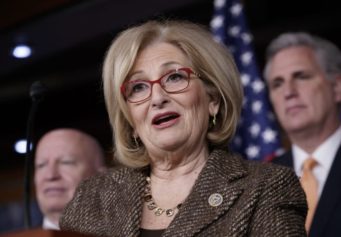
The Trump administration has proposed replacing the Supplemental Nutrition Assistance Program (SNAP) with a USDA Foods Package containing nonperishable items, including “shelf-stable milk, ready to eat cereals, pasta, peanut butter, beans and canned fruit and vegetables” but no fresh meat, fish or produce. (Photo: Phillytrib.com).
In a sign of a major cut to the social safety net and an assault on low-income people, the Trump administration wants to decide what food stamp beneficiaries should eat, and proposes the government give them packages of food. Under this proposal, most recipients of SNAP or the Supplemental Nutrition Assistance Program — the 80 percent who receive $90 or more in food assistance — would receive a “USDA Foods package.”
The 2019 budget proposal described the box as containing nonperishable items, including “shelf-stable milk, ready to eat cereals, pasta, peanut butter, beans and canned fruit and vegetables.” The processed food packages would not include fresh fruits and vegetables. This plan is part of a $213 billion or 30 percent proposed reduction in SNAP, which serves 42 million people, including 20 million children, over 10 years, $17 billion in 2019. More than 16 million households would see half of their SNAP benefits go to this food delivery service. A family of four eligible for SNAP must make no more than $31,980 per year, or less than 130 percent of the poverty line.
“USDA America’s Harvest Box is a bold, innovative approach to providing nutritious food to people who need assistance feeding themselves and their families — and all of it is homegrown by American farmers and producers. It maintains the same level of food value as SNAP participants currently receive, provides states flexibility in administering the program, and is responsible to the taxpayers,” U.S. Secretary of Agriculture Sonny Perdue said in a statement. Office and Management and Budget Director Mick Mulvaney described the food package idea as a “Blue Apron-type program where you actually receive the food instead of receiving the cash. It lowers the cost to us because we can buy prices at wholesale, whereas they have to buy it at retail. It also makes sure that they’re getting nutritious food. So we’re pretty excited about that. That’s a tremendous cost savings.” However, the high-end Blue Apron, unlike the USDA service, includes fresh ingredients such as meat, fish and produce that the customer selects.
Critics have condemned the Trump Harvest Box as inhumane and reminiscent of wartime rations and Great Depression-era soup lines. Joel Berg, CEO of Hunger Free America, told NPR the Trump plan would turn a “free market model” to “a far more intrusive, Big Government answer,” adding, “They think a bureaucrat in D.C. is better at picking out what your family needs than you are?”
Congresswoman Barbara Lee also tweeted that she found the proposal “offensive.” “As a single mother who relied on food stamps to help feed my boys, I can’t overstate how offensive this proposal is. Low-income families need more access to fresh produce & healthy foods, not less.”
According to the Food Research and Action Center, the harvest box is “a Rube-Goldberg designed system” that would replace the EBT cards that SNAP recipients use at supermarkets, grocery stores, farmers markets and elsewhere, and would be “costly, inefficient, stigmatizing, and prone to failure.” The nonprofit added that the “mind-boggling hundreds of billions of dollars’ worth of cuts and the ill-conceived programmatic distortions, if adopted, will mean much more hunger and poverty, worsened health, decreased ability of children to do well in school, and lower productivity for America.” The group pointed to recent research showing that SNAP is of critical importance in reducing food and economic insecurity, fighting poverty and improving the nation’s health and well-being.
In his 2011 book, “Time to Get Tough,” Trump warned of a “food stamp crime wave,” claiming half of SNAP recipients have been in the program for nearly a decade and attributing this to fraud. In recent years, Fox News has claimed the food stamp program is rife with fraud and waste, while in reality, fraud accounts for merely a penny on the dollar. With its sensationalistic 2013 report called “The Great Food Stamp Binge,” Fox News created a narrative of widespread SNAP abuse.
The gutting of SNAP is but one example of a proposed budget that represents a full assault on the social safety net, with deep cuts to Temporary Assistance to Needy Families or TANF (also known as welfare), $72 billion slashed from Social Security disability programs, $302 billion in Medicaid cuts and allowing states to impose work requirements and lifetime limits for Medicaid. The Trump administration hopes to cut $4 billion in federal student aid per year, and eliminate all $40 million in federal funding to a tuition aid program that helps D.C. residents attend college. The income-based loan repayment plans face sharp cuts, subsidized loans and the Public Service Loan Forgiveness Program would be eliminated entirely, and federal work study cut in half, with the government likely to more aggressively pursue delinquent student loan borrowers. As the Center for American Progress noted in a memo, this budget also calls for “huge cuts” to federal affordable housing programs, eliminates home heating assistance, and takes housing away from those who cannot find work.
Trump’s proposed FY19 budget is out. Over 10 years:
– $300+ billion cut to Medicaid
– $213 billion cut to SNAP
– $21 billion cut to TANF
– $72 billion cut to disability programs
– eliminates Social Svcs Block Grant (helps pay for child care and foster care) 1/— Chad Bolt (@chadderr) February 12, 2018
The budget would also eliminate a $2 billion program to increase the quality of teachers and school leaders, a $1.19 billion program for before- and after-school academic improvement centers, $190 million in grants for K-12 literacy instruction, and the $480 million budget for public broadcasting. As the Washington Post suggests, Trump’s slashing and burning of social programs is a classic Reaganesque “starving of the beast” in which Republicans pass an enormous tax cut to the wealthy and corporations — which just took place — causing increased deficits — the most recent tax cut delivers a $1.5 trillion bill — and thereby leaving no option but “savage” cuts to the safety net. This $4.4 trillion budget, which would $7 trillion to the deficit over 10 years, now goes to Congress for further deliberation.


